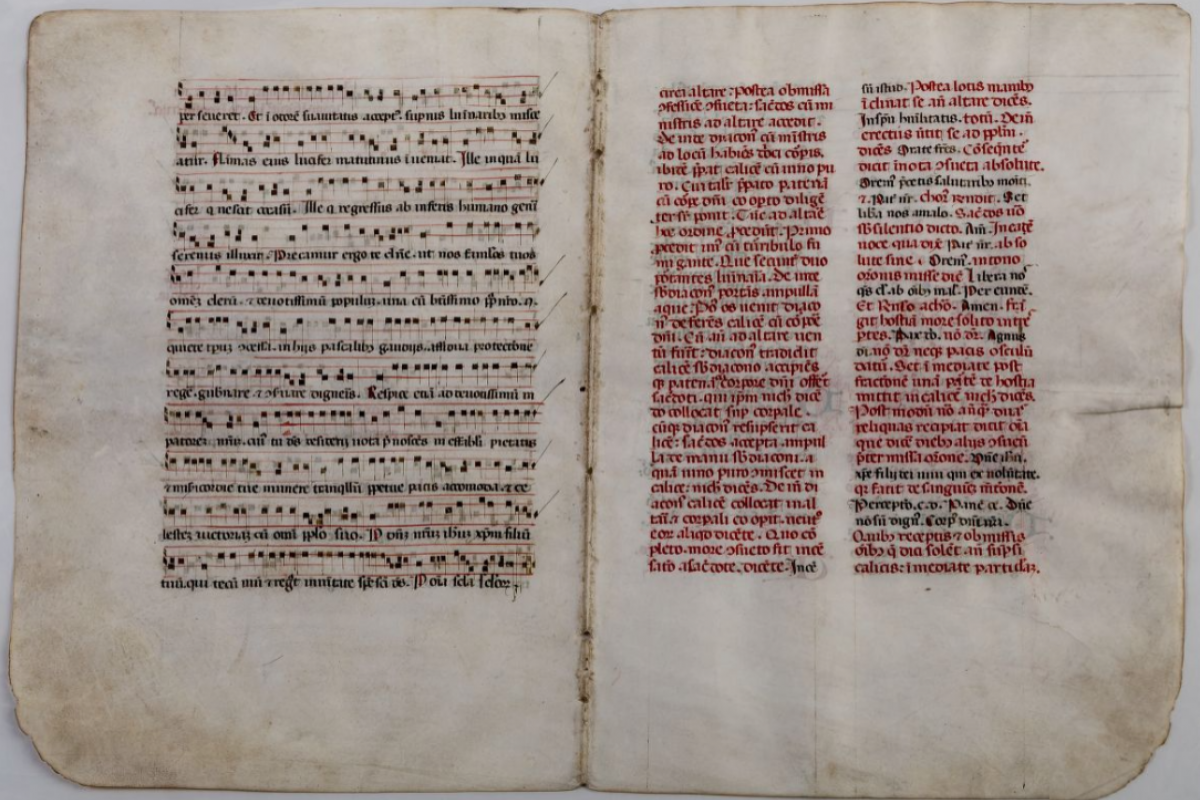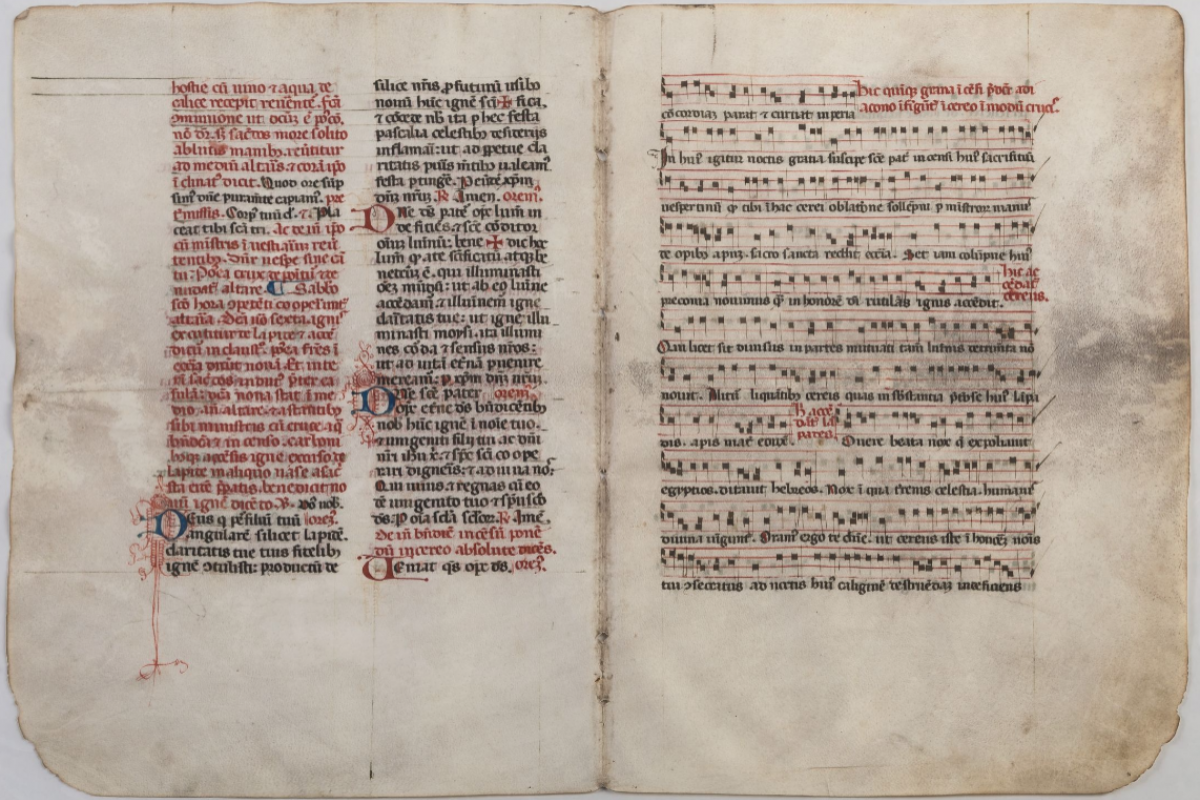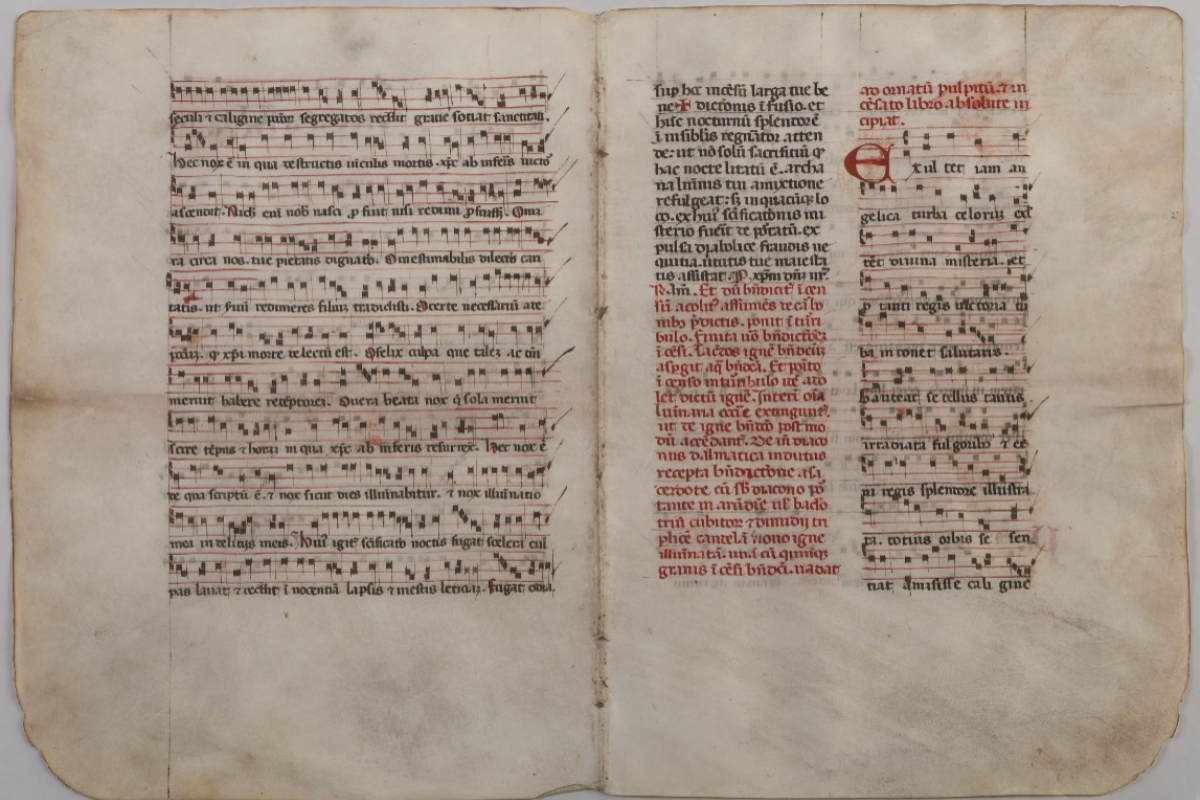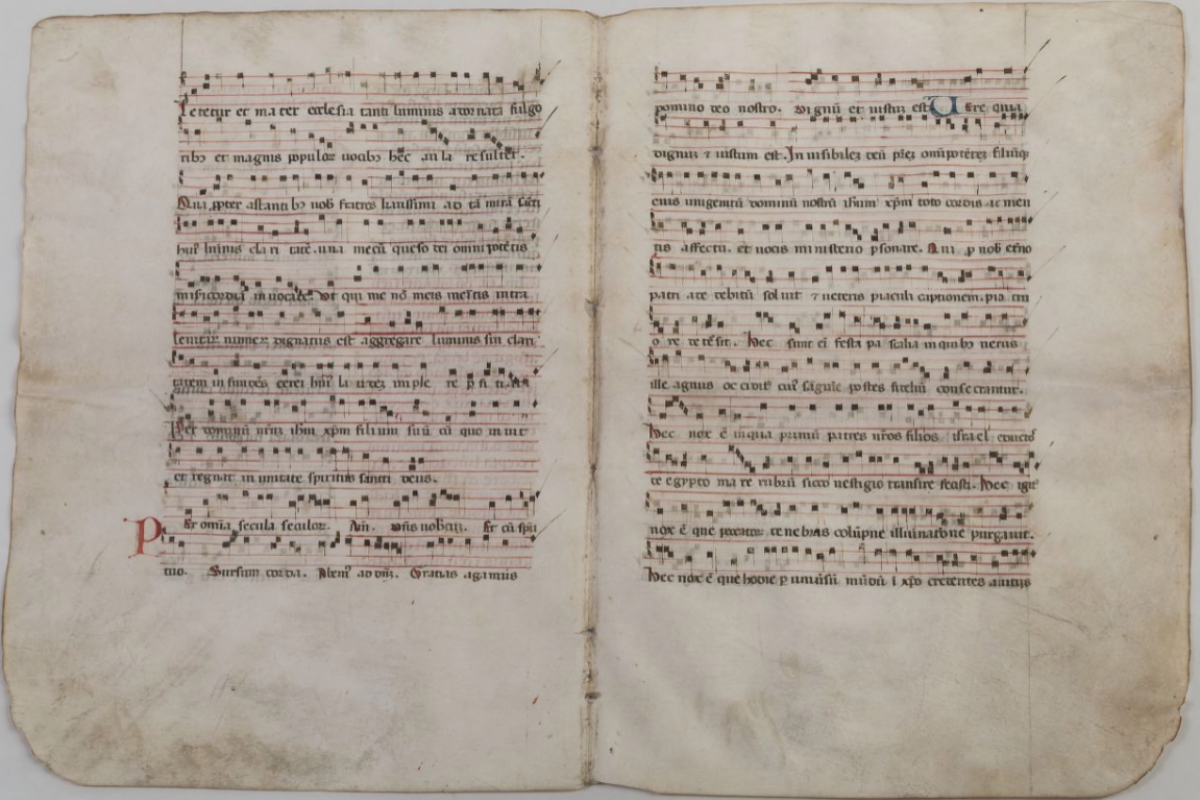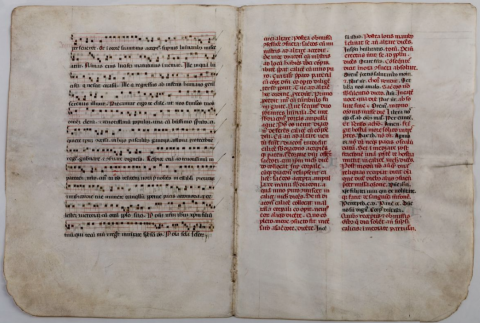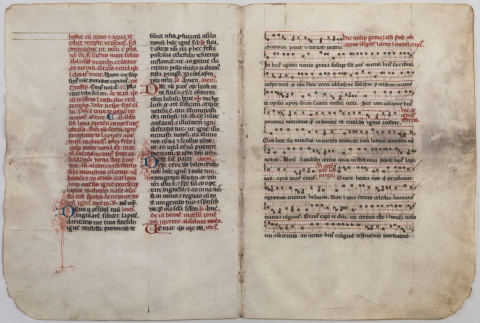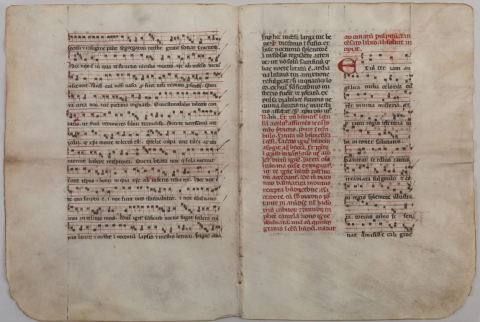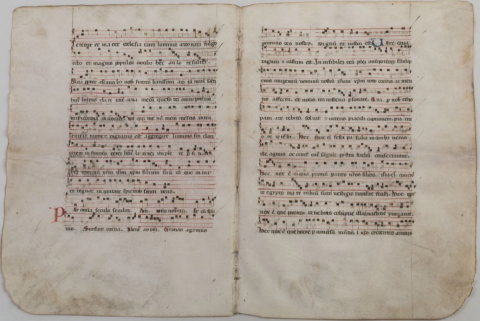Missal Fragment
Missal Fragment
Italian, early 14th century
Language: Latin
vellum
height 33 cm
width 24 cm
University of Portland, Clark Library, Ms. III E
Raymond Hill - Medieval Portland Capstone Student, 2008
The Missale, or Missal, titled Feria VI in Passione et morte domini was written for a very important mass which celebrated the passion and death of the Lord and was specifically performed on the night of Jesus’ death or Holy Saturday. The document that is held at the University of Portland library is not the complete manuscript but only a piece, the quarta parte actionis liturgicae seu de communio, or the fourth part of the liturgical acts which concerns the communion ceremony. A quick scan of the document reveals two bifolia or four pages of text, which are made of vellum. The script is a Gothic type known as rotunda, and the lettering is in black and red ink.[1] Interestingly some words or letters in the text contain a mix of red and black ink. The use of red with black ink seems to have served a few different purposes. The red ink, when mixed with black in a single word, was a restorative used to restore faded or worn ink. There are at least two examples of a red line used to strike through a letter written in black that was a mistake in spelling. Finally, it is possible that use of red with black ink was meant to be symbolic, representing the blood of Christ.
This piece functions as a liturgical document that details the words and chant music for the occasion of the mass. In this case the document details the mass for Holy Saturday or Easter Vigil. It is performed at night, the night of the death of Jesus, up to the blessing of new fire on the Holy Sabbath or Easter itself. The structure of the piece is one that is common to this type of liturgical document – the missal. The words and the music are interactive and supportive. In other words the priest speaks the words of the missal, which are written in black, with responses from the other ministris or attendants which are written in red. Following this message the music or chant is performed. This music, sung usually by the deacon, reinforces the message that has just been delivered.
But in this piece there is more than just the message or sermon followed by music. At the very beginning of the text a procession is described in which the priest, deacon and their attendants will "go about the altar" and then at the appropriate time the priest, with attendants is directed to "approach the altar." Other words written near to, but not in the text of the music, direct the movements of the procession: Hic ac cedat cereus. This part of the text states: "And this Candle passes by." Taking these directions as a whole it is apparent that this mass is one that is on the move, with the clergy holding the candle and in some meandering fashion ending up at the altar.
On another level the liturgical rite, of which this manuscript played a part, acted as entertainment. This sort of directing of participants in a holy reenactment of the death of Christ brings to mind images of a rudimentary play of sorts. What a spectacle this must have made. Imagine a huge cathedral of worshippers sitting in their pews, darkness enveloping them, until at last the procession of the Easter candle enters to the chants of the clergymen. This had to have been great entertainment as well as holy ritual. In fact it has been argued that the roots of Western drama lie in this sort of liturgical rite.[2]
A striking aspect of the text that was mentioned previously, in the overall description, is the use of black and red ink together in a single letter. This seemed odd that parts of a word or letter were of black ink and other parts of the same word or letter were done in red ink. On further inspection I began to wonder if this mixing was due to some sort of restorative or corrective work. For example in one part of the text the word "DNE" is written in black and then there is a red line through the “N.” I assumed the scribe intended the word to be "DE" which means: of or concerning. "DNE" then is obviously a mistake in the text and has been corrected by a red strike through.
Other instances of red and black in the same word or letter did not appear to be correcting a misspelling or restoring ink that had faded. I began to look at this from an art history perspective and upon reading scholarly works on Medieval manuscripts I learned that red could symbolize blood – the blood of Christ.[3] Taking this concept a little further maybe the scribe of this missal for the Easter Vigil intended the red to remind the reader of the suffering of the Savior by symbolizing the dripping of Christ’s blood over the words of the mass. The scribe inserted further symbolism concerning the crucifixion by placing crosses between the syllables of words. For example: "bene+dicition." That the symbolism in the text was done with these intentions cannot be proven. However, it seems reasonable to call attention to these characteristics of the text and to posit these theories especially in light of the fact that this missal was to be used for a mass in remembrance of the Passion and death of the Lord.
The cataloging notes outlined certain details about the structure of the manuscript. The notes for this piece states that the missal contained the Benedictione cerei paschalis, by St Augustine. It has been claimed that St. Augustine created the sermon of the Paschal candle that has come down to us in this and other manuscripts. This claim is said to be substantiated by the portion of his book "The City of God" in which he discusses his authorship of a piece called the laus cerei or "praise of the candle." However, St Ambrose, St Jerome and others have been given credit for authorship of this sermon as well.[4] Authorship by either Ambrose or Jerome is problematic as they both are recorded to have had disapproved of the text of the sermon. They both claimed the text had borrowings from Virgil's Georgics concerning bees which both church fathers ascribed to paganism.[5] Then there was the use of the cerei paschalis itself. The use of torches in processionals could be traced to pagan ritual.
The missal for the Easter Vigil is a complex piece. On one level it can be interpreted as a strictly medieval liturgical manuscript designed for the mass of the Easter Vigil. But looking slightly askance from its direct purpose the elements of drama become evident as well. The design of the piece is interesting as well from the perspective of its incorporation of symbols evidenced in the mixture of the coloring of the letters, which were intended to remind the congregation of the blood sacrifice of the Lamb of God, and the scattering of crosses seems to also reinforce the sacrifice by crucifixion.
Notes
[1] Dr. Dianne Tillotson, email message to author, July 8, 2008.
[2] Roger E. Reynolds. "The Drama of Medieval Liturgical Processions," Revue de musicology, T. 86e, No. 1er, (2000), p. 128.
[3] Amy Neff. "'Palma Dabit Palmam:' Franciscan Themes in a Devotional Manuscript." Journal of the Warburg and Courtauld Institutes, Vol. 65 (2002), p. 52.
[4] Thomas Forest Kelly. The Exultet in Southern Italy, (Oxford: Oxford University Press, 1996), p. 50.
[5] Ibid., p. 51.
Bibliography
Kelly, Thomas, Forest. The Exultet in Southern Italy, (Oxford: Oxford University Press, 1996).
Neff, Amy. "'Palma Dabit Palmam:' Franciscan Themes in a Devotional Manuscript." Journal of the Warburg and Courtauld Institutes, Vol. 65 (2002)
Reynolds, Roger E. "The Drama of Medieval Liturgical Processions," Revue de musicology, T. 86e, No. 1er, (2000)
Tillotson, Dianne, Dr. E-Mail message to author, July 8, 2008.
Wilma Fitzgerald, PhD, SP - Quoted with permission from an unpublished study
Missale. Feria vi in Passione et morte domini [de quarta parte actionis liturgicae seu de communio] usque Sabbato Sancto de benedictione novi ignis, de benedictione cerei paschalis. Saec. XIV. Two bifolia 330 x 240 (200 x 150) mm. Marginal prickings. Gothic script. Two columns of 32 lines. Exultet with music black neumes on 4 red line staves. Rubrics (extensive) in red. Text begins in the rubrics for feria vi.
// circa altare postea obmissa confessione consueta sacerdos cum ministris ad altare accedit. Deinde dyaconus cum ministris ad locum habens dominici corporis ibidem preperat calicem cum uino puro .../... ad celestem uictoriam cum omni populo suo. Per dominum nostrum ihesum christum filium tuum qui tecum uiuit et regnat in unitate spiritus sancti deus. Per omnia secula seculorum.

